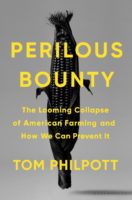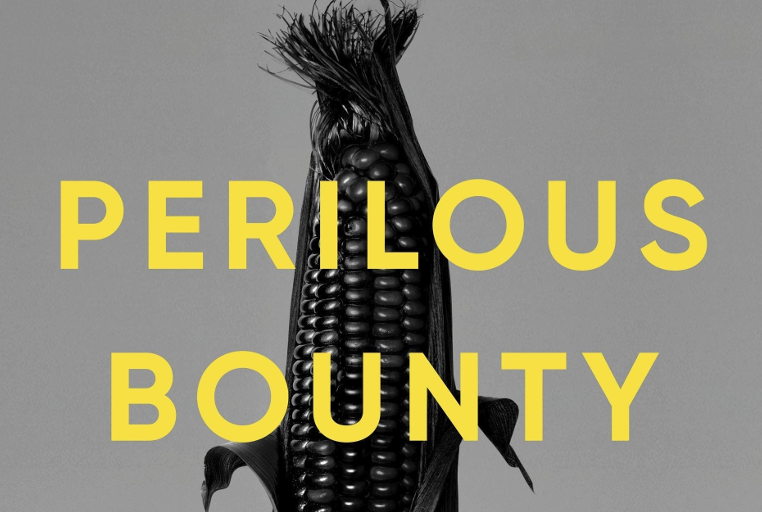 Tom Philpott has been writing about food and farming for Grist, Mother Jones, etc. Now he has a book out that examines the impending crises in US agriculture caused by short-sightedness, a relentless profit motive, and the power of corporations over US farm policy.
Tom Philpott has been writing about food and farming for Grist, Mother Jones, etc. Now he has a book out that examines the impending crises in US agriculture caused by short-sightedness, a relentless profit motive, and the power of corporations over US farm policy.
Philpott visits farmers who talk about their problems, and show him the results of bad farming practices in soil erosion, or lament their struggle to access enough irrigation water. He concentrates on two regions that provide quite a hefty chunk of the American diet: the big valley running through California and the Midwest. He says that valley is only one percent of US farmland but supplies just over half our fruits, vegetables and nuts. As for the Midwest, this region now produces primarily corn, soybeans and hogs, with the hogs on big farms in one place and the rest of the farms alternating between corn and soybeans. Most of the corn and soybean crops go into animal feed (which is why he says this region is central to meat production). In the case of corn, much goes into ethanol for fuel, despite the fact that it turns out that it take just about a gallon of gasoline to produce a gallon of the ethanol that was supposed to replace it. Both corn and soybeans also are primary ingredients in much processed food. Both, in the US, are mostly GMO.
Philpott’s key point is that these regions and the practices dominant within them are producing a bounty of cheap food for American and other consumers—but are doing this in a way that undermines the health and ecological integrity of their home regions, including the basis for the agriculture itself.
Predictably, the big issue in California is water. Climate change is reducing rainfall and especially the snowfall in the Sierras that used to send meltwater down the rivers into the valley in spring and summer when the rains have quit. Thus farms are depending on aquifers, which are being steadily depleted; but a law slated to go into effect in 2020 may change things.
One thing that surprised me and will likely surprise most readers, is that California’s water woes aren’t entirely about too little water. Research has shown that the region gets horrific floods every one to two centuries, covering the big valley ten feet deep; the last one was in 1862. That one was devastating; with an enormously increased population, oil wells and refineries and other pollution sources, the next one will be catastrophic.
The primary problem in the Midwest is soil erosion caused by highly intensive farming, but that area too sees air and water pollution, including from chemical fertilizer; farmworkers in both places are hit the hardest but the consequences are widespread, from residue in our food to a dead zone in the Gulf of Mexico—and climate change.
What’s clear is the logic of the market is not a logic of what’s best for humanity, but of short term profits for powerful interests, which prudently set aside funds for lobbying Washington to keep policies in place that benefit that bottom line.
Philpott’s prescriptions for solving these problems, for averting the disasters that lie ahead for consumers relying on an agricultural system that is profitable, productive–and rapidly consuming its own base–seemed to me the weakest part of the book. He profiles some farmers engaging in no-till agriculture with cover crops, and with increasing the diversity of their plantings, with proven results. But while these practices are spreading, they’re not spreading fast enough. Philpott names a study showing that one Iowa county could produce most of the fruits and vegetables for the Midwest, thus reducing reliance on California, but he doesn’t carry this as far as Chris Smaje does in A Small Farm Future. Smaje, I think, is assuming that the fertilizers and pesticides and monster machines—and the fuel to run them—won’t be around much longer. Without them, diversifying and relocalizing agriculture over the whole country may not just make sense—it may be inevitable. But who can say when this will happen—and meanwhile the damage goes on.
Waiting for the nation’s big farmers to overcome their reluctance to try something new and adopt regenerative practices—rather than continuing to rely on subsidies to stay in the black, seems dubious. Additionally, many farmers may get sucked into the “digital” or “precision” snake oil now being peddled by the big ag companies. This technology merges data from crop yields in past years with satellite and weather info; it could be a good thing, advising farmers that certain acreages have such consistently low yield that they should let them go fallow, thus reducing costs and allowing a pollinator refuge. But the oligopolies are buying up the startups, so it seems more likely that they will advise using more chemicals on those areas, slightly improving the yield while further increasing the profit loss—and the ecological damage. They are also trying to position themselves as a one-stop-shop which can control a farmer’s every decision, supplying all the inputs, machinery and directions. I’ve heard talk of farming robots—maybe they can really perfect this approach by replacing the farmers with robots.
And while there are obvious policy changes that could protect soils, aquifers, the food supply and farmers, we can’t get these policy changes as long as the oligopolies run Washington. Biden has appointed Tom Vilsack, known as “Mr. Monsanto,” to run the Agriculture Department. So it doesn’t look like we can expect the changes we need to come from government—absent a loud and energetic grassroots movement for change. The voices in that movement would do well to inform themselves with the details found in this book.





